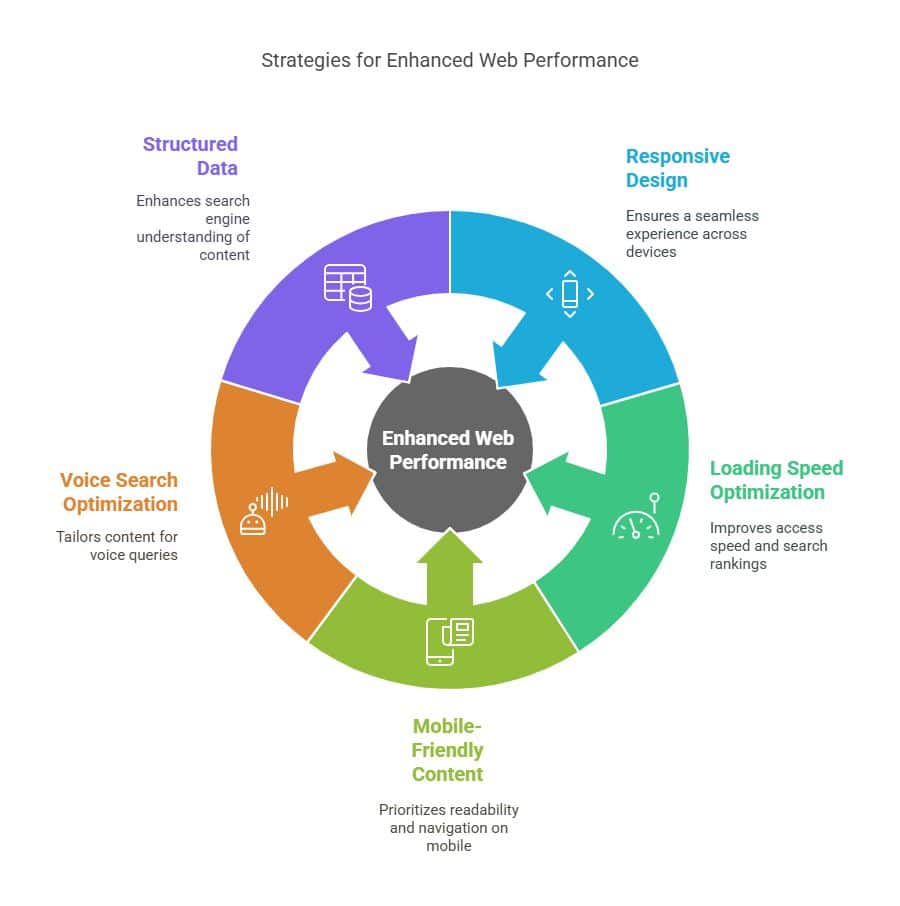
7 Best Practices for Mobile SEO Optimization
To effectively optimize your mobile SEO, start by implementing responsive design to ensure your site works seamlessly across different devices. Maintaining fast loading speeds is also crucial—techniques like AMP (Accelerated Mobile Pages) and image optimization can help achieve this. When it comes to content, focus on creating mobile-friendly formats that are concise and engaging, incorporating local keywords to attract nearby users. Optimize your images by compressing them and using responsive formats to ensure they load quickly on any device. Don’t forget about voice search! Prioritize optimization by using conversational keywords and enhancing your local search strategies for location-based queries. Utilizing structured data through schema markup can also improve your content’s visibility in search results. Finally, conduct thorough mobile site testing to identify any performance issues and ensure everything runs smoothly. By following these best practices, you’ll align with current SEO strategies, leading to improved user experiences and higher search rankings. For more actionable insights, keep to know how to optimize mobile sites for SEO!
Key Takeaways
- Use responsive design to guarantee a smooth user experience on a range of screens and devices.
- For faster access and higher rankings, use loading speed optimization strategies like AMP and picture compression.
- Give top priority to mobile-friendly content that is easy to read, navigate, and optimize for local keywords.
- To satisfy user intent, modify information for voice search by utilizing conversational keywords and semantic search techniques.
- Use structured data to create rich snippets for increased user interaction and to increase the visibility of content.

1. Responsive Design

In the world of mobile SEO optimization, responsive design is key to creating a smooth user experience across all types of devices. With more people accessing websites through smartphones and tablets, it’s essential to use layouts that adapt dynamically to different screen sizes and orientations. This flexibility not only improves mobile navigation but also allows users to easily browse through content without having to scroll excessively or zoom in. By prioritizing responsive design, you ensure that your site is accessible and user-friendly, making it easier for visitors to find what they need and enjoy their browsing experience.
Implementing viewport settings is a key element of responsive design. These settings tell the browser how to display the content of the webpage based on the size of the device. The integrity of the design and readability on smaller displays are maintained when viewport settings are properly configured to guarantee that text, images, and other media elements scale appropriately.
Moreover, touch targeting is an essential consideration within responsive design. Given the prevalence of touchscreens on mobile devices, interactive elements such as buttons and links must be designed with sufficient size and spacing to accommodate finger taps. This not only improves the user experience by reducing accidental clicks but also contributes to the overall accessibility of the site.
Effective mobile navigation is another critical aspect of responsive design. Simplified menus and intuitive navigation paths help users find the information they need quickly and efficiently. By prioritizing ease of use, websites can reduce bounce rates and increase engagement, leading to better SEO performance.
2. Fast Loading Speed

Achieving fast loading speed is paramount in mobile SEO optimization, as it significantly impacts user experience and search engine rankings. Users expect swift access to information, and delays can lead to increased bounce rates and diminished engagement. Google and other search engines prioritize mobile performance metrics when determining page rankings, making it crucial for websites to optimize loading times.
To enhance speed, one effective strategy is the implementation of Accelerated Mobile Pages (AMP). AMP implementation strategies focus on creating lightweight pages that load almost instantly, providing a seamless user experience. These simplified versions of web pages strip down unnecessary elements, focusing on essential content and improving load times dramatically.
Leveraging mobile analytics tools provides valuable user experience insights necessary for optimizing loading speeds. By analyzing data from these tools, you can identify bottlenecks and areas requiring improvement, ensuring that your site delivers the fastest possible experience. Page speed tools like Google PageSpeed Insights and GTmetrix are instrumental in diagnosing speed issues and offering actionable recommendations.
Furthermore, optimizing images, minimizing redirects, and utilizing browser caching are practical measures to enhance loading speed. Image optimization involves compressing files without compromising quality, thereby reducing load times. Minimizing redirects prevents unnecessary delays caused by URL redirection, while browser caching allows returning visitors to access stored resources quickly.
Monitoring and continuously refining your website’s performance using these techniques will not only improve user satisfaction but also boost your site’s visibility in search engine results. Fast loading speed is an essential component of a successful mobile SEO strategy, and its importance cannot be overstated.
3. Mobile-Friendly Content

Crafting mobile-friendly content is essential for ensuring an optimal user experience and improving search engine rankings on mobile devices. As mobile usage continues to rise, adapting content to be easily digestible on smaller screens is imperative. This involves several key factors, such as content readability, local search optimization, touch navigation, and social sharing capabilities.
To enhance mobile user experience, content readability should be prioritized. This means using concise sentences, bullet points, and headers to break down information efficiently. Additionally, ensuring that text and visuals are scaled appropriately for smaller devices will further facilitate ease of reading.
| Key Aspect | Best Practice |
| Content Readability | Use short paragraphs, headers, and bullet points. |
| Local Search | Optimize content with local keywords. |
| Touch Navigation | Ensure buttons are easy to tap on small screens. |
| Social Sharing | Integrate social sharing buttons prominently. |
Local search optimization is another crucial element. Including location-specific keywords and information helps your content become more relevant to users searching from mobile devices in specific areas, thus improving visibility in local searches.
Touch navigation should not be overlooked. Mobile-friendly content must include large, easily tappable buttons and links to enhance navigation and reduce user frustration. This approach ensures that users can effortlessly interact with your site, maintaining their engagement.
Lastly, social sharing is a powerful tool for extending the reach of your content. By integrating prominent social sharing buttons, you encourage users to share your content within their networks, amplifying visibility and engagement.
4. Optimized Images
Effective mobile SEO requires a strategic approach to image optimization, which significantly enhances page load speed and user experience. In today’s digital landscape, where users demand quick access to information, optimizing images is crucial for maintaining competitive advantage.
Image compression techniques are pivotal in reducing file sizes without compromising quality, thereby accelerating loading times. Tools such as TinyPNG or JPEGmini can be employed to achieve optimal compression, ensuring that visual content remains crisp and engaging.
The alt text importance cannot be overstressed, as it not only aids accessibility for visually impaired users but also provides search engines with context about the images. Crafting descriptive and relevant alt text enhances SEO by linking visual content to pertinent searches, thereby increasing visibility.
Furthermore, incorporating responsive image formats like WebP and SVG allows images to scale seamlessly across various device sizes, thus ensuring a consistent user experience. These formats are designed to adapt to diverse screen resolutions, optimizing performance and visual appeal.
Implementing lazy loading benefits page performance by deferring the loading of non-essential images until they are actually needed. This strategy minimizes initial load times and conserves bandwidth, particularly beneficial for users on mobile networks with limited data.
5. Voice Search Optimization
With the growing prevalence of voice-activated devices, voice search optimization has become an essential aspect of mobile SEO strategy. As voice search trends continue to rise, businesses must adapt to capitalize on this shift in consumer behavior.
Voice searches, often executed through smartphones and smart speakers, are naturally more conversational. This necessitates the use of conversational keywords within content, reflecting the way people speak rather than type.
Implementing semantic search strategies is crucial in understanding the context and intent behind voice queries. This involves focusing on user intent and the context surrounding search terms, rather than relying solely on exact keyword matches. By doing so, businesses can ensure their content aligns more closely with what users are genuinely seeking.
Furthermore, local search optimization plays a pivotal role in voice search. Many voice searches are location-based, such as inquiries about nearby services or businesses. Ensuring your business information is accurate and up-to-date across local listings and map services can significantly enhance visibility in local voice search results.
The voice user interface (VUI) is another element to consider. It’s important to design content that facilitates an easy and intuitive interaction with voice-activated devices.
This means crafting responses that are clear, concise, and informative, as users expect quick and straightforward answers to their queries.
6. Structured Data Usage

In the realm of mobile SEO, structured data acts as a blueprint, guiding search engines to better understand and index content. By implementing structured data types, webmasters can enhance the visibility of their content, making it more accessible and appealing to both search engines and users.
At the core of structured data usage lies the concept of schema markup, a form of microdata that provides additional context to web content. This enhanced context facilitates the generation of rich snippets, snippets that appear in search results and provide users with a preview of the information they can expect to find on a webpage.
Mobile indexing has become a priority for search engines, emphasizing the need for mobile-friendly websites that are optimized for mobile devices. Structured data types play a crucial role in this landscape, as they ensure that search engines can accurately interpret and rank mobile content.
The use of schema markup in mobile SEO is particularly beneficial, as it aids in the seamless transition to mobile-first indexing by highlighting key elements of a webpage that are relevant to mobile users.
One effective way to implement structured data is through JSON LD implementation. JSON LD, or JavaScript Object Notation for Linked Data, provides a lightweight and flexible method for embedding structured data on a webpage.
This approach allows for easy integration and maintenance of structured data, contributing to improved mobile indexing and user experience. By leveraging JSON LD and schema markup, webmasters can optimize their mobile sites, ensuring that they are well-positioned to meet the demands of both search engines and mobile users.
7. Mobile Site Testing

Achieving optimal performance in mobile SEO necessitates rigorous mobile site testing. This crucial step ensures that your website meets the growing demands of mobile users, providing a seamless user experience across various devices.
Mobile testing tools, such as Google’s Mobile-Friendly Test and BrowserStack, are invaluable in evaluating your site’s responsiveness and performance. They offer insights into how your site appears and functions on different devices, identifying areas for improvement to enhance cross device compatibility.
A comprehensive testing approach should also incorporate the evaluation of accessibility features. Ensuring that your mobile site is accessible to users with disabilities not only broadens your audience but also aligns with best practices in inclusivity. Tools like Axe and WAVE can assist in identifying accessibility issues, offering guidance on modifications to make your site more user-friendly.
Mobile analytics play a fundamental role in understanding how users interact with your site. By analyzing metrics such as bounce rates, session duration, and conversion paths, you can pinpoint potential obstacles in the user journey. This data-driven approach enables you to make informed decisions about where to focus your optimization efforts.
Furthermore, consistency in performance and appearance across devices is paramount. Testing should cover a range of smartphones and tablets, ensuring that your site functions efficiently irrespective of screen size or operating system.
Cross device compatibility testing ensures that your mobile site maintains its integrity and functionality, providing a cohesive experience for users regardless of their chosen platform.
Final Thoughts
Optimizing your mobile SEO is essential in today’s digital landscape, where mobile usage continues to rise. By implementing responsive design, ensuring fast loading speeds, and creating mobile-friendly content, you can significantly enhance the user experience on your site. Additionally, optimizing images and focusing on voice search strategies will further engage visitors and improve your site’s visibility in search results. Utilizing structured data enhances the way search engines interpret your content, increasing the chances of rich snippets in search results. Finally, rigorous mobile site testing ensures that your website performs well across various devices, helping to identify and rectify any potential issues.
Looking to boost your mobile SEO performance and achieve lasting digital success? Connect with Syville Gacutan, an experienced SEO Specialist in the Philippines. With a proven track record in mobile optimization, technical SEO, and search visibility enhancement, Syville can help your business reach new heights online. Contact Syville today and start transforming your mobile presence.